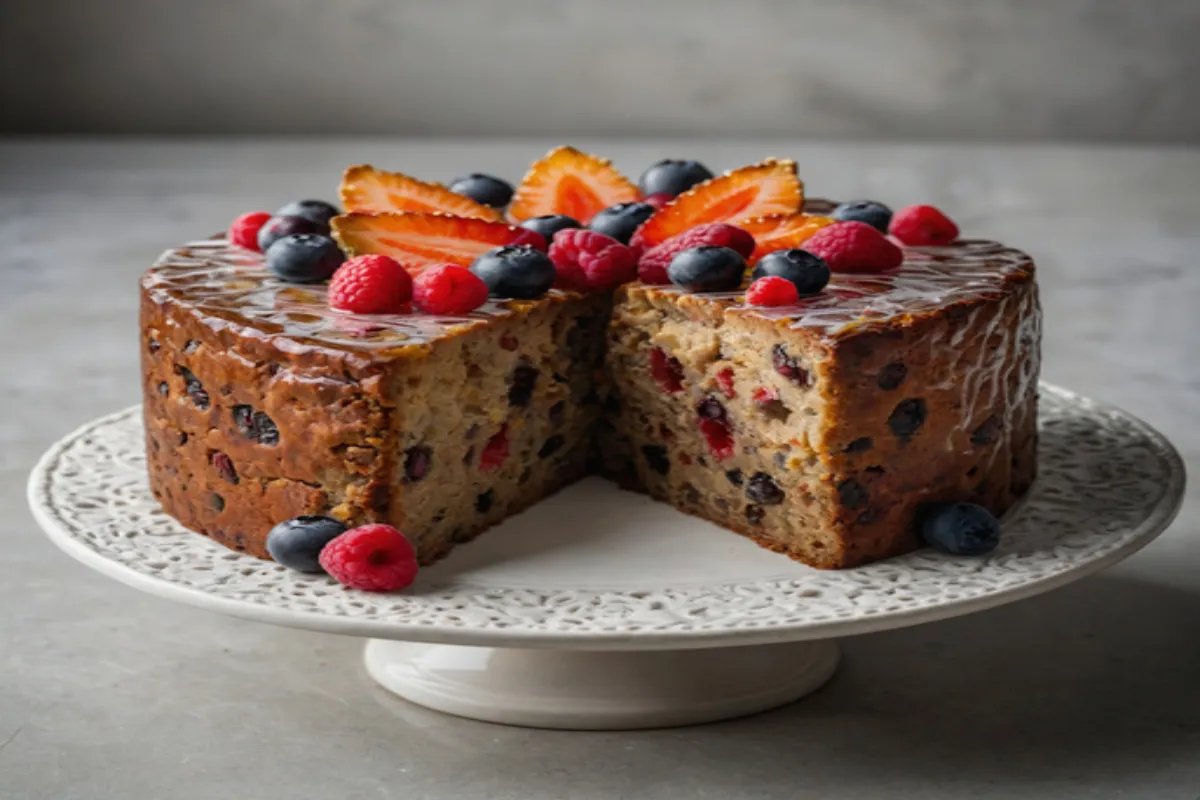When it comes to holiday traditions, fruitcake stands out as one of the most iconic and, at times, polarizing desserts. People either love it or dislike it, but its place in festive foods around the world is undeniable. Known for its dense, moist texture and rich flavors from candied fruits, nuts, and spices, fruitcake has earned a significant reputation during Christmas and other celebrations. Despite its controversial status, there’s a great deal of history, culture, and flavor packed into this classic holiday dessert.
In this guide, we explore everything about fruitcake—its origins, ingredients, global variations, baking tips, proper storage methods, and where to find the best fruitcakes if you don’t want to bake one yourself. By the end, whether you already love fruitcake or are just curious, you’ll gain a deeper appreciation for this festive treat.
The Origins of Fruitcake
People have enjoyed fruitcake for centuries. The earliest known recipe dates back to ancient Rome, where cakes consisted of barley, pomegranate seeds, nuts, and dried fruit. As sugar became more available during the Middle Ages, dried fruits turned into a luxury that bakers used to enhance their cakes. Fruits were preserved in sugar, and alcohol like brandy or rum extended the cake’s shelf life.
During the Renaissance, European bakers began adding more exotic ingredients brought in from trade routes, including spices and candied fruits. These cakes became popular at festive occasions like Christmas and weddings, due to their luxurious nature. The high sugar content and alcohol preserved them, making them ideal for long-lasting celebrations.
By the 18th century, fruitcake had gained popularity across Europe, especially in England, where baking a fruitcake for Christmas or weddings became a solid tradition. Brides frequently served fruitcake as a wedding cake, with the top layer reserved for the couple’s first anniversary—a tradition still practiced in some cultures today.
In the United States, fruitcake found a different reception. While it gained popularity as a Christmas gift during the 19th and early 20th centuries, it eventually earned a reputation as the “gift nobody wants.” However, millions of fruitcakes continue to be baked, sold, and enjoyed each year, especially in households that maintain the tradition.
What Exactly Is Fruitcake Made Of?
The ingredients in a fruitcake can vary significantly depending on the recipe, but most traditional fruitcakes include core components. These elements combine to create the rich, dense cake that we recognize as fruitcake.
Candied Fruits and Dried Fruits
The fruits in fruitcake give it its signature sweetness and moistness. Typically, candied fruits and dried fruits create this texture. Here are some of the most commonly used fruits:
- Candied Cherries: These bright red and green fruits add color and sweetness.
- Dried Pineapple: Known for its tropical flavor, dried pineapple balances the richness of the other ingredients.
- Raisins: Whether golden or dark, raisins provide chewiness and natural sweetness.
- Dates and Figs: These dried fruits add a richer, more robust flavor to the cake.
Other fruits, such as dried apricots, prunes, or currants, may also be included, depending on the recipe.
Nuts
Nuts add texture and depth to fruitcake, creating a pleasant contrast with the softer fruits. Some common nuts in fruitcake recipes include:
- Pecans: Especially popular in the southern United States, pecans offer a buttery crunch.
- Walnuts: With their earthy flavor, walnuts are another popular choice for fruitcake.
- Almonds: Almonds are often used in European fruitcakes to create a subtle nuttiness.
Some recipes include hazelnuts or macadamia nuts for added crunch and flavor.
Spices
Spices are crucial in giving fruitcake its warm, holiday flavor. Traditional spices in fruitcake recipes include:
- Cinnamon: Adds warmth and enhances the sweetness of the fruit.
- Nutmeg: Contributes a subtle depth of flavor.
- Cloves: Adds a slightly spicy kick, providing contrast to the sugary fruits.
- Allspice: A blend of cinnamon, nutmeg, and cloves, allspice rounds out the flavors.
Some recipes may also include additional spices such as ginger or cardamom for a unique twist.
Alcohol
One of the defining elements of fruitcake is alcohol. Rum, brandy, or sherry typically soak the dried fruits before being mixed into the cake batter. After baking, brushing the cake with more alcohol enhances its flavor and helps preserve it. Many recipes suggest aging the cake for several weeks or months to allow the flavors to develop fully.
If you’re making fruitcake at home and want tips on balancing your ingredients, check out this comprehensive guide on baking cakes for helpful insights.
Global Variations of Fruitcake

Although fruitcake is widely associated with Christmas, many cultures have their versions, each reflecting local traditions, ingredients, and flavor preferences. Here are some of the most popular types of fruitcake from around the world.
British Fruitcake
The British version of fruitcake is perhaps the most well-known. It’s dense and dark, often soaked in brandy and filled with dried fruits like currants, raisins, and sultanas. British fruitcake is often covered with a layer of marzipan and royal icing for weddings and special occasions. This version has been served as a wedding cake in the UK for centuries, with the top layer reserved for the couple’s first anniversary.
American Southern Pecan Fruitcake
In the southern United States, pecans take center stage. Southern fruitcakes are typically lighter in color and texture than their British counterparts. They often feature fewer dried fruits and more nuts, particularly pecans. The alcohol content is generally lower, resulting in a sweeter, more mildly flavored cake. Some Southern bakers even skip the alcohol entirely, opting for a syrup glaze instead.
If you’re interested in other ways to use nuts in desserts, this article on common desserts is a great resource for incorporating fruits and nuts into a variety of sweet treats.
German Stollen
Germany’s stollen is a yeast-based cake that’s much lighter than most other versions of fruitcake. It’s typically made with dried fruits, nuts, and a thick layer of marzipan in the middle. After baking, the cake gets a coating of powdered sugar, giving it a festive appearance. Stollen is often eaten during the Christmas season and pairs perfectly with a cup of coffee or tea.
Italian Panettone
Italy’s contribution to the world of fruitcake is panettone. This tall, airy cake is made with yeast and filled with candied citrus and raisins. Its light, fluffy texture contrasts with the dense, heavy fruitcakes of other countries. Panettone is typically served during the Christmas season and is often enjoyed with coffee or a sweet wine.
Jamaican Black Cake
In Jamaica and other parts of the Caribbean, fruitcake is known as Black Cake. This version includes fruits soaked in rum for months, resulting in an extremely moist, dark cake. The long soaking process gives the cake a deep, rich flavor that stands out from other fruitcakes. It’s commonly served at weddings and during Christmas celebrations.
How to Make Fruitcake at Home: Step-by-Step Guide
Although store-bought fruitcakes are widely available, baking your own offers a special touch. Here’s a step-by-step guide to help you create a delicious homemade fruitcake.
Step 1: Soak the Fruits
Start by soaking your dried fruits in alcohol. Combine candied fruits and dried fruits, such as raisins, cherries, and pineapple, with brandy or rum. Let them soak for at least 12 hours, though some bakers soak fruits for up to a week for more intense flavor.
Step 2: Prepare the Cake Batter
Next, prepare the cake batter by creaming butter and sugar until light and fluffy. Add eggs, one at a time, mixing well after each addition. In a separate bowl, mix together the flour, spices, and baking powder. Gradually add the dry ingredients to the wet mixture, alternating with milk or orange juice to maintain a smooth batter.
Step 3: Mix in the Fruits and Nuts
Once the batter is smooth, fold in the soaked fruits and chopped nuts, ensuring even distribution. Be gentle to avoid overmixing.
Step 4: Bake the Cake
Pour the batter into a prepared cake pan and smooth the top. Bake at a low temperature, around 275°F, for several hours. Slow baking ensures the cake cooks evenly without drying out.
Step 5: Age the Cake
Once the cake has cooled, wrap it in cheesecloth soaked in brandy or rum. Then, wrap it tightly in plastic wrap or foil and store in an airtight container. Let the cake age for at least a month before serving, brushing it with more alcohol every few weeks to keep it moist.
For inspiration on perfecting other types of cakes, check out this guide on the most delicious cakes to expand your baking skills.
Storing and Preserving Fruitcake

One of the reasons fruitcake has endured for so long is its impressive shelf life. The combination of sugar and alcohol helps preserve the cake for extended periods, making it an ideal dessert to prepare in advance. Here’s how to store your fruitcake:
- Room Temperature: Wrap it tightly in plastic wrap and store in an airtight container if you plan to eat the cake within a few weeks.
- Refrigeration: For longer storage, refrigerate the cake. Properly wrapped, it will stay fresh for several months.
- Freezing: Fruitcake freezes well and can be stored for up to a year. Wrap it in plastic wrap and foil to prevent freezer burn.
The flavors of fruitcake often improve with time, so don’t hesitate to let your cake age for weeks or even months.
FAQs About Fruitcake
How long does fruitcake last?
Properly stored fruitcake can last for months, or even years. The alcohol preserves it, and many people find that the flavor improves over time as the cake ages.
Can I make fruitcake without alcohol?
Yes, you can substitute alcohol with fruit juice. However, the cake won’t last as long, and the flavor will be milder.
What’s the difference between fruitcake and regular cake?
Fruitcake is denser and has a higher ratio of fruits and nuts. It’s also soaked in alcohol and aged, which gives it a unique texture and taste compared to regular cakes.
Can you freeze fruitcake?
Yes, fruitcake freezes well. Wrap it tightly in plastic and foil before freezing. It can last up to a year.
Conclusion
Though fruitcake is often joked about, it remains a festive treat with a rich history and global variations. Whether you prefer the traditional British version, a lighter Italian panettone, or the bold flavors of Jamaican Black Cake, there’s a fruitcake for every taste. Whether you bake it yourself or buy one from a bakery, you’re sure to enjoy this classic holiday dessert.

